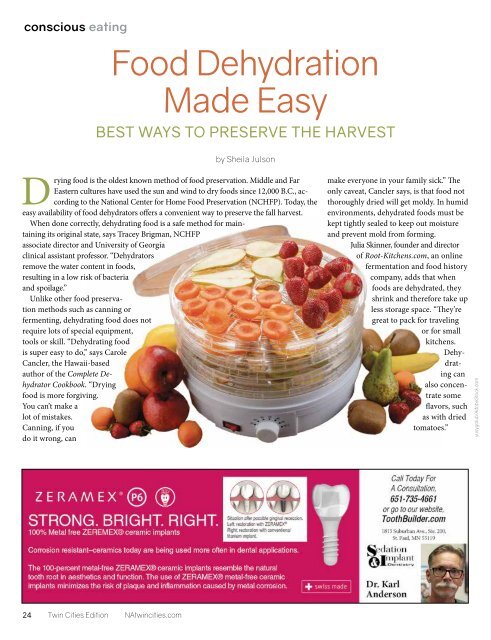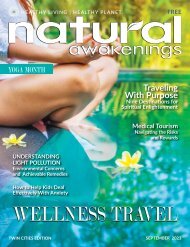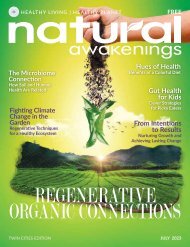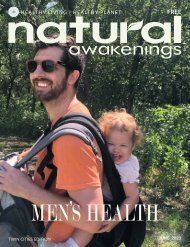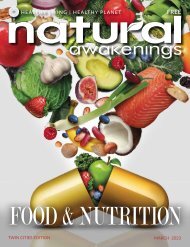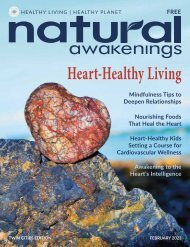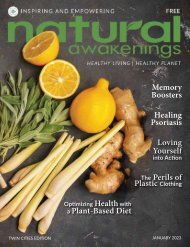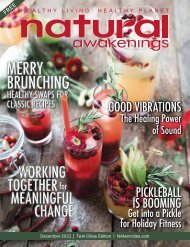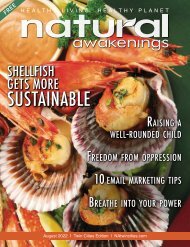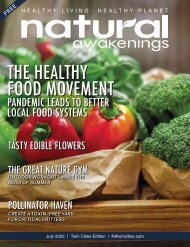Natural Awakenings Twin Cities September 2022
Read the September 2022 edition of Natural Awakenings Twin Cities magazine. This is our annual Inspired Living Issue which features articles on living younger, living life of full color, learning to grieve, conscious consumerism, back-to-school eco-echoes, heading off headaches, mysteries of healing, health an happiness connection, food dehydration made easy, and so much more! Be sure to check out our local content, including News Briefs announcements, Community Resource Guide with providers throughout the metro who can meet your individual wellness needs, and all the happenings in the Calendar of Events. There is additional online-only content that can be found at NATwinCities.com.
Read the September 2022 edition of Natural Awakenings Twin Cities magazine. This is our annual Inspired Living Issue which features articles on living younger, living life of full color, learning to grieve, conscious consumerism, back-to-school eco-echoes, heading off headaches, mysteries of healing, health an happiness connection, food dehydration made easy, and so much more!
Be sure to check out our local content, including News Briefs announcements, Community Resource Guide with providers throughout the metro who can meet your individual wellness needs, and all the happenings in the Calendar of Events. There is additional online-only content that can be found at NATwinCities.com.
You also want an ePaper? Increase the reach of your titles
YUMPU automatically turns print PDFs into web optimized ePapers that Google loves.
conscious eating<br />
Food Dehydration<br />
Made Easy<br />
BEST WAYS TO PRESERVE THE HARVEST<br />
by Sheila Julson<br />
Drying food is the oldest known method of food preservation. Middle and Far<br />
Eastern cultures have used the sun and wind to dry foods since 12,000 B.C., according<br />
to the National Center for Home Food Preservation (NCHFP). Today, the<br />
easy availability of food dehydrators offers a convenient way to preserve the fall harvest.<br />
When done correctly, dehydrating food is a safe method for maintaining<br />
its original state, says Tracey Brigman, NCHFP<br />
associate director and University of Georgia<br />
clinical assistant professor. “Dehydrators<br />
remove the water content in foods,<br />
resulting in a low risk of bacteria<br />
and spoilage.”<br />
Unlike other food preservation<br />
methods such as canning or<br />
fermenting, dehydrating food does not<br />
require lots of special equipment,<br />
tools or skill. “Dehydrating food<br />
is super easy to do,” says Carole<br />
Cancler, the Hawaii-based<br />
author of the Complete Dehydrator<br />
Cookbook. “Drying<br />
food is more forgiving.<br />
You can’t make a<br />
lot of mistakes.<br />
Canning, if you<br />
do it wrong, can<br />
make everyone in your family sick.” The<br />
only caveat, Cancler says, is that food not<br />
thoroughly dried will get moldy. In humid<br />
environments, dehydrated foods must be<br />
kept tightly sealed to keep out moisture<br />
and prevent mold from forming.<br />
Julia Skinner, founder and director<br />
of Root-Kitchens.com, an online<br />
fermentation and food history<br />
company, adds that when<br />
foods are dehydrated, they<br />
shrink and therefore take up<br />
less storage space. “They’re<br />
great to pack for traveling<br />
or for small<br />
kitchens.<br />
Dehydrating<br />
can<br />
also concentrate<br />
some<br />
flavors, such<br />
as with dried<br />
tomatoes.”<br />
yuriygolub/AdobeStock.com<br />
24 <strong>Twin</strong> <strong>Cities</strong> Edition NAtwincities.com


